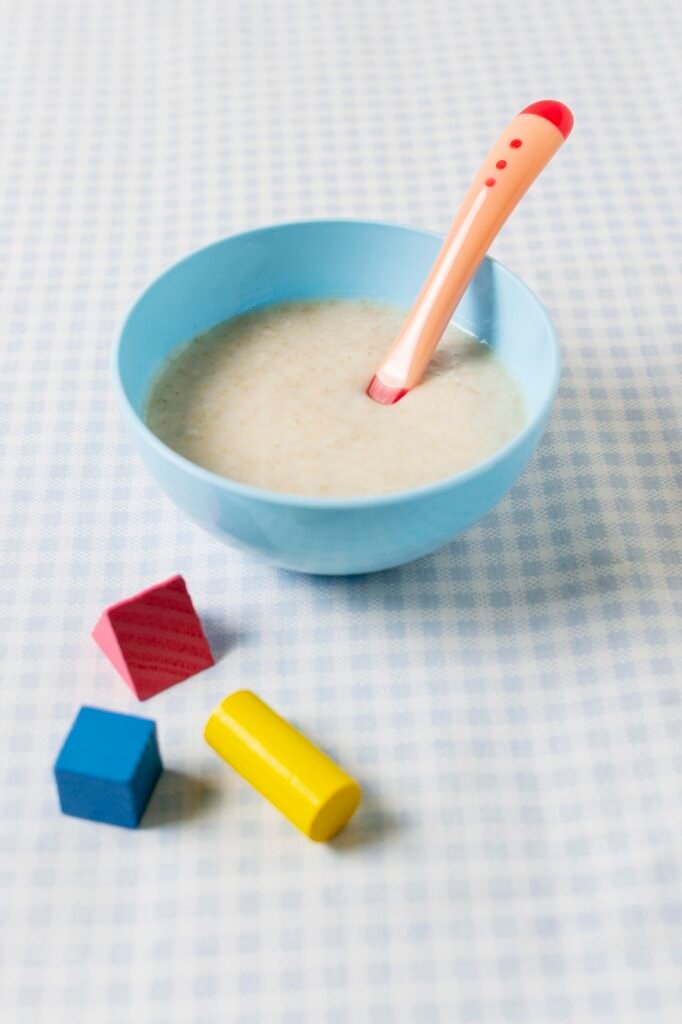Introducing foods to your baby is the most exciting part of their growth and development. Among the first foods parents often consider is rice cereals, a popular choice because of its mild flavor and ease of digestion. But the question is, when will be the right time for introducing rice cereal into your baby’s diet? Understanding your baby’s developmental readiness and nutritional needs makes this transition smooth. This guide will take a look at the right age for starting rice cereal, the signs your baby is ready, and tips to ensure a safe and positive feeding experience.
Understanding Your Baby’s Readiness for Solid Foods

It basically requires observing the developmental stages of your baby to understand when he or she is ready for solid foods. Generally, experts recommend starting solids, including rice cereal, between four and six months of age. However, readiness isn’t solely determined by age; physical and behavioral signs play an important role.
Watch for the infant to be able to hold their head steady and sit up with minimal support. Losing the tongue-thrust reflex-that pushes food out of the mouth-may also signal readiness. Other signs that may indicate readiness include heightened interest in watching others eat and reaching out for food on your plate.
Besides that, it is very relevant to consult with the pediatrician even before starting up the solids, which is crucial for the digestive system. Your understanding of these factors will facilitate a perfect time for introducing rice cereal, setting a very easy transition to solid foods.
The Recommended Age for Introducing Rice Cereal
Generally, the recommendation for rice cereal is anywhere between four and six months. It is at this stage that most babies can start developing the physical and neurological capabilities to eat foods other than milk. The American Academy of Pediatrics has recommended that one should try to wait until your baby has reached at least four months for their digestive system to mature enough to take in foods other than milk.
But every baby is different, and some might not be ready until they near six months or beyond. Look for developmental clues like good head control, an ability to sit upright while supported, and a tongue-thrust reflex that’s becoming minimal.
You should, however, always consult with your pediatrician before giving rice cereal or any other solids. They can advise you regarding your baby’s growth and nutritional needs and, most importantly, general health status. This would ensure that rice cereal is given at a time when it is appropriate for your baby’s healthy development.
Signs Your Baby is Ready to Try Rice Cereal
Knowing when your baby is ready for rice cereal will make it a very positive and safe feeding experience. Here are some key signs to look out for:
- Improved Head and Neck Control
Your baby should be able to hold their head steady and sit upright with support, which is important for safe swallowing. - Loss of the Tongue-Thrust Reflex
Newborn babies have a reflex that automatically pushes food out of their mouths using their tongue. If this reflex has weakened, they are ready for solids. - Interest in Food
If your baby watches you eat, reaches for your food, or opens their mouth when offering a spoon, they may be giving a sign of readiness to explore solids like rice cereal.
Increased Appetite
Babies who appear to be hungry after frequent feedings and wake more often for feeding may be ready to start solid foods.
If most of these signs are evident in your baby, and s/he is four to six months old, rice cereal could be a good option to introduce. Always check with your pediatrician before the transition to begin.
How to Safely Prepare and Serve Rice Cereal
Preparation and serving of rice cereal to your baby should be done with care for its safety and appeal. Here’s a step-by-step guide to make the experience smooth and worry-free.
Choose the Right Cereal
Opt for an iron-fortified rice cereal that is particularly made for infants. Check the label for added nutrients and that the product is free from artificial additives or sweeteners.
Mix to the Right Consistency
Mix one tablespoon of rice cereal with four to five tablespoons of breast milk, formula, or water. This will result in a smooth, thin paste that is not too thick for your baby to swallow.
Introduce Small Quantities
Begin with one or two spoonfuls of cereal to introduce your baby to the new texture and taste. Gradually increase the amount as they become more comfortable.
Use a Spoon, Not a Bottle
Always offer rice cereal with a spoon and never from a bottle, as it presents a choking hazard or can be overfed.
Monitoring of Feeding Sessions
Stick around during feeding and encourage your baby while watching for fullness and discomfort cues. If your baby turns their head away or closes their mouth, they might be done.
Gradual Introduction to New Foods
Rice cereal is a common first food for babies, but as you introduce more and more solids, wait three to five days between new foods to monitor for any allergic reactions.
By following these steps, you will be able to safely introduce rice cereal and set the foundation for a healthy eating journey.
Alternatives to Rice Cereal for Your Baby’s First Foods
While rice cereal is a popular first food for most babies, there are many other nutritious options. Offering a variety of foods early in life exposes your baby to different tastes and textures, which will help develop his palate, along with providing a wide range of essential nutrients. Here are some great alternatives:
Oatmeal Cereal
Oatmeal cereal is a gentle and nutritious option that is less likely to cause constipation than rice cereal. It’s also a good source of fiber and iron.
Barley Cereal
Barley cereal is another nutritious first food that is full of vitamins and minerals. Its mild flavor and smooth texture make it easy for babies to enjoy.
Mashed Fruits
Good first foods include bananas and avocados. Bananas are sweet and easily digested, while avocados are a healthy fat source for the developing brain.
Pureed Vegetables
Sweet potatoes, carrots, or squash are all good, mild vegetables to start with. These vegetables are rich in vitamins and minerals and have a natural sweetness babies love.
Iron-Fortified Baby Foods
Other iron-fortified baby foods, such as quinoa or multigrain infant cereals, offer a nutritious option other than rice cereal.
As with any food, each baby will like certain things and not others. Keep introducing foods while watching for food intolerances or allergies. Consult your pediatrician before giving your baby any new food to make sure it’s appropriate nutritionally.
Top-Rated Baby Rice Cereals You Can Try Today
Finding the right baby rice cereal makes the introduction to solids so much easier and more enjoyable for your little one. Following are top-rated options for baby rice cereal that most parents and pediatricians generally recommend:
Gerber Baby Rice Cereal
The trusted choice of many families, Gerber Baby Rice Cereals is known for its great smooth texture and added iron. It’s easy to mix and enriched with vitamins and minerals to support healthy growth.
Happy Baby Organic Probiotic Baby Cereal
This organic option features probiotics added to be gentle on baby’s delicate digestive system. It contains whole grains, is iron-fortified, and thus very nutritious.
Earth’s Best Organic Whole Grain Rice Cereal
Organic-certified and with whole grain content, this cereal gives your baby necessary nutrition like iron, zinc, and B vitamins, excluding all artificial additives.
Beech-Nut Stage 1 Single Grain Rice Cereal
A simple and easy-to-digest option, Beech-Nut’s rice cereal is ideal for babies just starting solids. It mixes smoothly and has a mild flavor.
Gerber Organic Single Grain Rice Cereal
This organic variation of the Gerber classic is perfect for families prioritizing organic ingredients. It’s fortified with iron and free from GMOs.
These baby rice cereals are available in most places and are made with added features to aid in your baby’s health and development. Be sure to check the ingredient list and take advice from your pediatrician to choose the best option for your baby.
Conclusion
Introducing rice cereal to your baby is such an exciting milestone, and knowing just when and how to safely do so really makes for a very positive experience. By understanding readiness cues, timing, and proper cereal preparation, one can easily transition the baby smoothly and joyfully into solid foods. While rice cereal is a very popular first food, there are many healthy alternatives to consider, too. Always take the advice of your pediatrician to make informed decisions based on your baby’s needs. With the right approach, this can be a great opportunity to help your baby grow and develop well.
